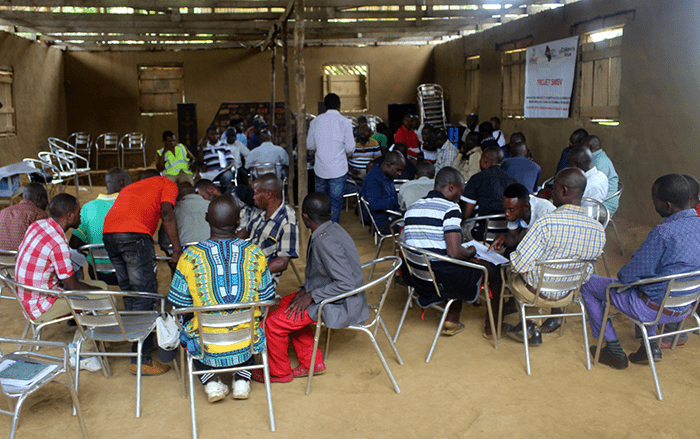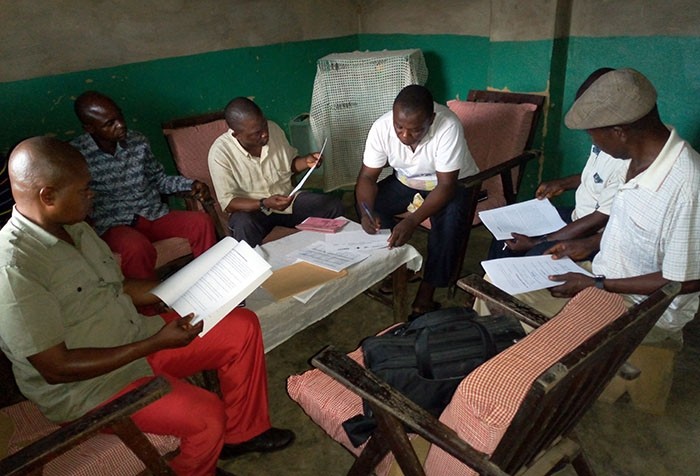Feature
SMSV project creates new dynamic for monitoring mining activities for Mapimo sub-monitoring committee
The Shabunda territory is the largest and one of the most landlocked territories in South Kivu province in Democratic Republic of the Congo. The territory’s population makes a living mainly from the exploitation and trade of gold and 3T (tin, tantalum, tungsten) minerals, however, the majority of active mining sites is neither qualified nor validated. The Sustainable Mine Site Validation (SMSV) project, funded by USAID, aims to establish a sustainable model for the qualification and validation of artisanal 3T and gold mining sites with the participation of grassroots communities. In September 2019, with the support of the provincial minister of mines for South Kivu, the project began working in four sectors of the territory, including Mapimo.
In Mapimo, SMSV set up a multi-stakeholder local committee for monitoring mining activities and trained the committee on the OECD Due Diligence Guide, the Regional Certification Mechanism of the International Conference on the Great Lakes Region and the laws of DRC, as well as crosscutting approaches of the project such as the fight against child labor, sexual and gender-based violence and whistleblowing. The local committee includes 52 people from the political-administrative authority, customary authority, state mining services including mining inspectors/controllers from the Service for Assistance and Supervision of Artisanal and Small Scale Mining organization (SAEMAPE) and the Division of Mines, security services, civil society organizations, mining cooperatives, traders, transporters, financial managers and local leaders. Following the training, committee members, led by mining inspectors/controllers and with guidance and support from Pact and its team of trainers, successfully carried out the first qualification and validation visits to mining sites in the Mapimo area, which included the assessment and recording of risks identified in and around the sites. The qualification and validation team then agreed on steps to mitigate any identified risks. Going forward, the committee will conduct ongoing monitoring.
Due to the lack of qualified and validated sites in the Mapimo area, gold, 3T and other accompanying minerals have been unvalued, leading to unrealized benefits. Qualifying and validating sites in a timely fashion and with adequate ongoing monitoring opens the door to the formalization of mineral exploitation and trade, and to generating revenues for local communities and ultimately, for the territory. Multi-stakeholder committees are critical to success. Mr. Kyelu Mbusu Eugène, Head of Mapimo's Administrative Management Post and chair of the Mapimo committee agrees that with the establishment and training of local committees, and support from the SMSV project, the sector could achieve formalization and economic benefits for all. “I want to ensure that this committee works well so that any risks that could arise occur in the supply chain of minerals from Mapimo find a solution here on the spot,” said Mr. Eugène.
Through SMSV’s approach, Mapimo’s multi-stakeholder committee including mining inspectors/controllers have qualified 14 mining sites. The National Minister of Mines is now set to confirm the validation of the sites by an official decree, highlighting the success of the qualification team. The president of the Mapimo Civil Society, Mr. Kabongo Mombe Adrien, said: "If the SMSV approach, which involves the actors at local level in the process of qualification and validation of mining sites, had been implemented for a long time, Mapimo would be among the first mineral producing sectors in the territory and even in the province. This is why we have decided to monitor the risks and the qualification visits to all the other mining sites in the Mapimo sector."

The transformative power of the project’s approach is being felt at the local level where, even before the publication of the official validation order for qualified sites, committee members organized a session to develop mitigation measures and started to implement monitoring actions with the authorities, aiming to resolve the identified risks within the mining sites.
During this pilot mission in Shabunda territory, Pact and its partners trained a total of four committees including Mapimo, which included 141 committee members. Trained CLS members and mining inspectors/controllers visited 38 mining sites in Shabunda territory for their qualification and validation. The project also trained 70 women on gender, equity and organizational development, aiming to strengthen their representation and participation in mining activities – but this is another story yet to come! The project is currently planning its next activities in North Kivu.

Project Overview
The USAID-Pact Sustainable Mine Site Validation (SMSV) Project is a four-year cooperative agreement awarded to Pact by the United States Agency for International Development (USAID). The project aims to reduce conflict that builds off the illegal mining and trade of 3TG (tin, tantalum, tungsten and gold) by implementing a new Mine Site Qualification and Validation (Q&V) model in North and South Kivu, DRC that:
- Is financially and technically sustainable.
- Meets all requirements in the OECD Due Diligence Guidance (DDG) for Responsible Supply Chains of Minerals from Conflict-Affected and High-Risk Areas (CAHRAs), the International Conference on the Great Lakes Region (ICGLR) Regional Certification Mechanism (RCM), and DRC law.
- Allows for adequate flexibility on the ground to enable Q&V of new mine sites in a timely fashion and in accordance with local needs.
SMSV will fully build the capacity of DRC Mining Inspectors/Controllers and local multi-stakeholder committees (CLS) to conduct Q&V missions, adequately monitoring mining activities at all sites and addressing/mitigating identified risks at these sites. Independent monitoring will be ensured through a whistleblowing and rapid-alert mechanism. A particular emphasis will be placed on gender and child labor by raising awareness of local stakeholders and developing strategies to fight child labor and increasing the representation of women in mining.